缝线基础知识
- 格式:ppt
- 大小:1.01 MB
- 文档页数:41
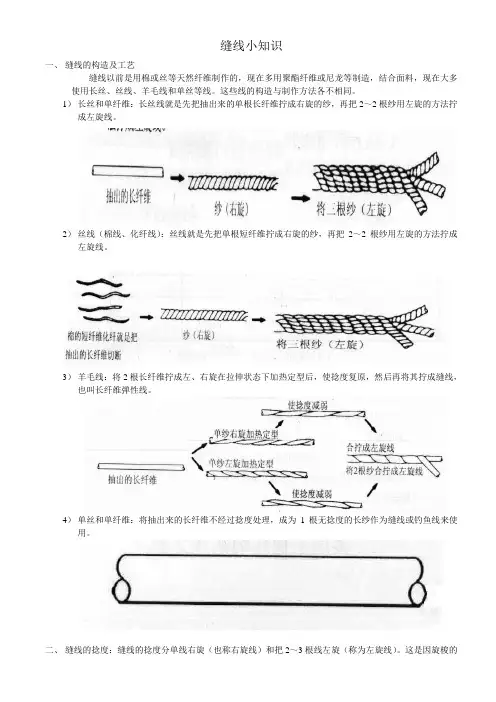
缝线小知识一、缝线的构造及工艺缝线以前是用棉或丝等天然纤维制作的,现在多用聚酯纤维或尼龙等制造,结合面料,现在大多使用长丝、丝线、羊毛线和单丝等线。
这些线的构造与制作方法各不相同。
1)长丝和单纤维:长丝线就是先把抽出来的单根长纤维拧成右旋的纱,再把2~2根纱用左旋的方法拧成左旋线。
2)丝线(棉线、化纤线):丝线就是先把单根短纤维拧成右旋的纱,再把2~2根纱用左旋的方法拧成左旋线。
3)羊毛线:将2根长纤维拧成左、右旋在拉伸状态下加热定型后,使捻度复原,然后再将其拧成缝线,也叫长纤维弹性线。
4)单丝和单纤维:将抽出来的长纤维不经过捻度处理,成为1根无捻度的长纱作为缝线或钓鱼线来使用。
二、缝线的捻度:缝线的捻度分单线右旋(也称右旋线)和把2~3根线左旋(称为左旋线)。
这是因旋梭的方向而防止散股的的缘由;在正逢的场合针孔与缝线摩擦力减少,因缝线不散股,所以性能较稳定。
反过来说,如果正逢时使用右旋线,针孔与缝线摩擦力增大,缝线易散股,散线股形成的线泡容易产生跳针和断线等故障。
注:捻度判断方法:右旋线又称S向旋线,左旋线又称Z向旋线。
用左手将线向左拧,看缝线螺旋方向左上右下的称为右旋线,右上左下的为左旋线。
越拧越紧的为左旋线。
三、缝线的粗细表示方法:缝线的粗细、长度与重量成比例的,因为纤维的断面不是圆形,不能以直径表示,而是用长度和质量的关系来表示,其表示的以长度为基准的称为恒长式表示法;以重量为基准的称为恒重式表示法。
1)恒长式表示法:主要数据DTEX(旦西单库史)和D(旦尼尔)。
A、旦西单库史(译音):对线长10000米来说每1克线的重量称为1旦西单库史。
几乎所有的线都是以这种方式来表示粗细的。
B、旦尼尔:测量生丝或人造丝的一个单位。
对线长9000米来说线的重量1克为1旦尼尔。
绢或化纤线以这种方法来表示粗细的。
2)恒重式表示法:分公制和英制。
A、公制式:线重1公斤长度为1000米称为1#线,线重1公斤长度为长2000米称为2#线。
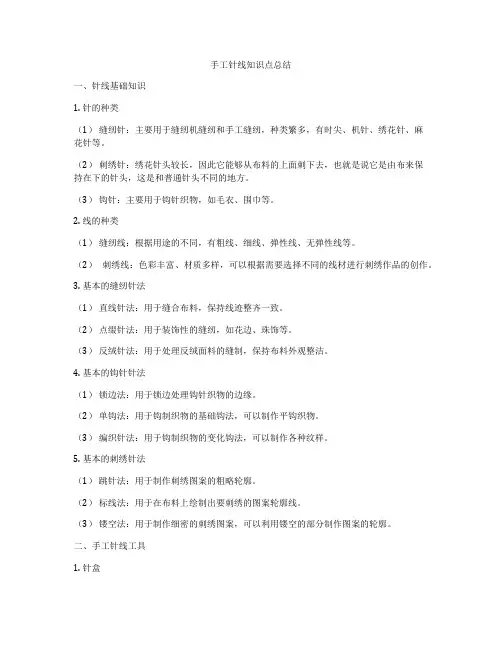
手工针线知识点总结一、针线基础知识1. 针的种类(1)缝纫针:主要用于缝纫机缝纫和手工缝纫,种类繁多,有时尖、机针、绣花针、麻花针等。
(2)刺绣针:绣花针头较长,因此它能够从布料的上面刺下去,也就是说它是由布来保持在下的针头,这是和普通针头不同的地方。
(3)钩针:主要用于钩针织物,如毛衣、围巾等。
2. 线的种类(1)缝纫线:根据用途的不同,有粗线、细线、弹性线、无弹性线等。
(2)刺绣线:色彩丰富、材质多样,可以根据需要选择不同的线材进行刺绣作品的创作。
3. 基本的缝纫针法(1)直线针法:用于缝合布料,保持线迹整齐一致。
(2)点缀针法:用于装饰性的缝纫,如花边、珠饰等。
(3)反绒针法:用于处理反绒面料的缝制,保持布料外观整洁。
4. 基本的钩针针法(1)锁边法:用于锁边处理钩针织物的边缘。
(2)单钩法:用于钩制织物的基础钩法,可以制作平钩织物。
(3)编织针法:用于钩制织物的变化钩法,可以制作各种纹样。
5. 基本的刺绣针法(1)跳针法:用于制作刺绣图案的粗略轮廓。
(2)标线法:用于在布料上绘制出要刺绣的图案轮廓线。
(3)镂空法:用于制作细密的刺绣图案,可以利用镂空的部分制作图案的轮廓。
二、手工针线工具1. 针盒(1)缝纫针盒:用于存放各种缝纫针,保持整齐清洁。
(2)针线盒:用于存放各种缝纫用品,如线、针、剪刀等。
2. 基本的缝纫工具(1)缝纫机:用于加快缝纫作业的效率,可以进行各种直线、曲线、花样缝纫。
(2)剪刀:用于裁剪布料和线材,保持锋利,避免影响缝制效果。
3. 基本的刺绣工具(1)刺绣架:用于固定绣布,方便进行刺绣作业。
(2)刺绣针:用于刺绣作业,长度和粗细根据需要选择不同的刺绣针。
4. 基本的钩针工具(1)钩针:用于钩制织物的工具,大小根据需要选择不同的钩针。
(2)计数器:用于记录钩制织物的行数,保持织物整齐一致。
三、针线常见问题及处理方法1. 缝纫中的常见问题(1)手工缝纫针脱线:可以用缝纫机来解决,或者重新用针线缝制。
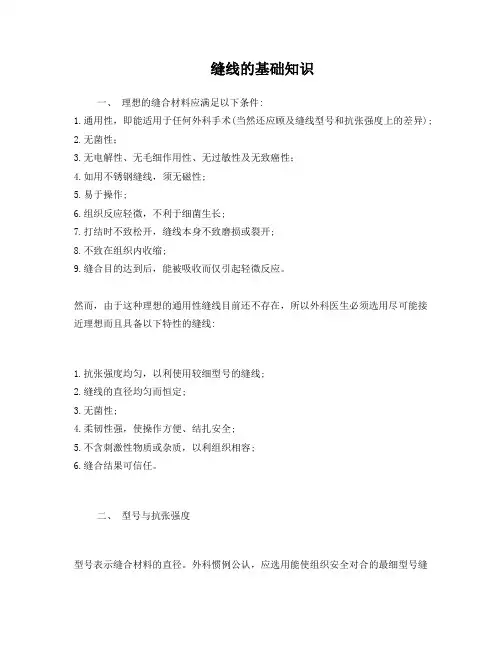
缝线的基础知识一、理想的缝合材料应满足以下条件:1.通用性,即能适用于任何外科手术(当然还应顾及缝线型号和抗张强度上的差异);2.无菌性;3.无电解性、无毛细作用性、无过敏性及无致癌性;4.如用不锈钢缝线,须无磁性;5.易于操作;6.组织反应轻微,不利于细菌生长;7.打结时不致松开,缝线本身不致磨损或裂开;8.不致在组织内收缩;9.缝合目的达到后,能被吸收而仅引起轻微反应。
然而,由于这种理想的通用性缝线目前还不存在,所以外科医生必须选用尽可能接近理想而且具备以下特性的缝线:1.抗张强度均匀,以利使用较细型号的缝线;2.缝线的直径均匀而恒定;3.无菌性;4.柔韧性强,使操作方便、结扎安全;5.不含刺激性物质或杂质,以利组织相容;6.缝合结果可信任。
二、型号与抗张强度型号表示缝合材料的直径。
外科惯例公认,应选用能使组织安全对合的最细型号缝线,使缝合所致的创伤减至最低限度。
缝线的型号以数字表示:"0"号以上,数码越大,缝线越粗,如3号粗于1号;从"0"开始,"0"号越多,直径越小,抗张强度亦越低。
缝线结的抗张强度是其在断裂前所能承受的力度(以磅表示)。
有关组织的抗张强度是外科医生选择缝线型号和抗张强度的先决条件。
外科医生还应了解,缝线强度渐减和伤口抗张强度渐增间的相互关系,以及植入材料所致的异物反应是否影响组织的愈合过程。
一般公认,缝线的抗张强度不需超过组织的抗张强度,但至少应与其所缝的正常组织等强。
国产缝线规格与国际规格对应关系:国内: 1 4 7 10国际:3/0 2/0 0 1三、单纤维与多纤维缝线单纤维缝线由单一纤维制成,在穿过组织时所遇阻力较小,且可避免细菌在上附着。
由于这些品性,特别适用于血管外科。
单纤维缝线易于打结。
但在操作和结扎时必须谨慎从事,因折叠或卷曲都可能给缝线造成缺口或薄弱点,以致断裂。
四、可吸收性与不可吸收性缝线可吸收性缝线是由健康哺乳动物的胶原或人工合成的多聚体制备而成。
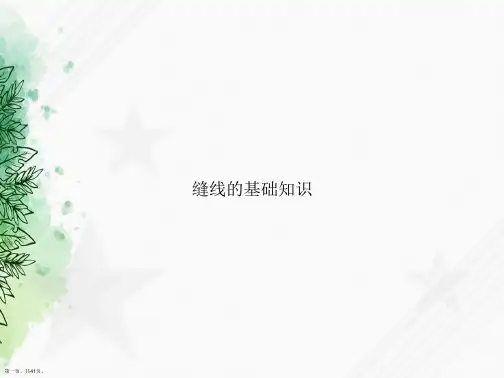
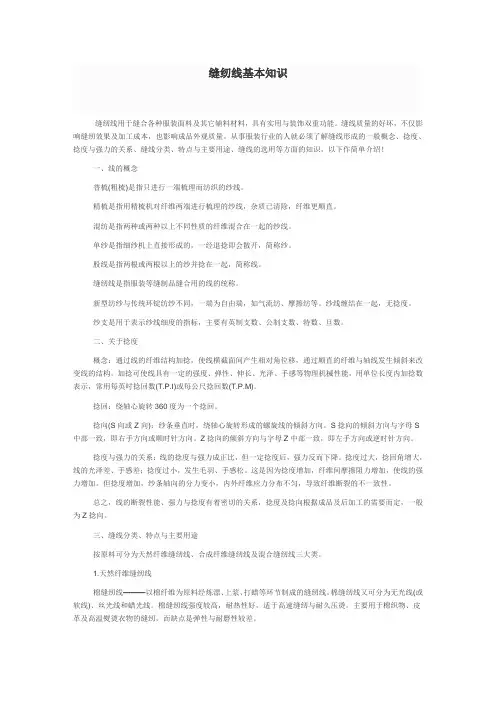
缝纫线基本知识缝纫线用于缝合各种服装面料及其它辅料材料,具有实用与装饰双重功能。
缝线质量的好坏,不仅影响缝纫效果及加工成本,也影响成品外观质量。
从事服装行业的人就必须了解缝线形成的一般概念、捻度、捻度与强力的关系、缝线分类、特点与主要用途、缝线的选用等方面的知识,以下作简单介绍!一、线的概念普梳(粗梳)是指只进行一端梳理而纺织的纱线。
精梳是指用精梳机对纤维两端进行梳理的纱线,杂质已清除,纤维更顺直。
混纺是指两种或两种以上不同性质的纤维混合在一起的纱线。
单纱是指细纱机上直接形成的,一经退捻即会散开,简称纱。
股线是指两根或两根以上的纱并捻在一起,简称线。
缝纫线是指服装等缝制品缝合用的线的统称。
新型纺纱与传统环锭纺纱不同,一端为自由端,如气流纺、摩擦纺等。
纱线缠结在一起,无捻度。
纱支是用于表示纱线细度的指标,主要有英制支数、公制支数、特数、旦数。
二、关于捻度概念:通过线的纤维结构加捻,使线横截面间产生相对角位移,通过顺直的纤维与轴线发生倾斜来改变线的结构。
加捻可使线具有一定的强度、弹性、伸长、光泽、手感等物理机械性能,用单位长度内加捻数表示,常用每英吋捻回数(T.P.I)或每公尺捻回数(T.P.M)。
捻回:绕轴心旋转360度为一个捻回。
捻向(S向或Z向):纱条垂直时,绕轴心旋转形成的螺旋线的倾斜方向。
S捻向的倾斜方向与字母S 中部一致,即右手方向或顺时针方向。
Z捻向的倾斜方向与字母Z中部一致,即左手方向或逆时针方向。
捻度与强力的关系:线的捻度与强力成正比,但一定捻度后,强力反而下降。
捻度过大,捻回角增大,线的光泽差、手感差;捻度过小,发生毛羽、手感松。
这是因为捻度增加,纤维间摩擦阻力增加,使线的强力增加。
但捻度增加,纱条轴向的分力变小,内外纤维应力分布不匀,导致纤维断裂的不一致性。
总之,线的断裂性能、强力与捻度有着密切的关系,捻度及捻向根据成品及后加工的需要而定,一般为Z捻向。
三、缝线分类、特点与主要用途按原料可分为天然纤维缝纫线、合成纤维缝纫线及混合缝纫线三大类。

缝纫线缝纫线用于缝合各种服装材料,具有实用与装饰双重功能。
缝线质量的好坏,不仅影响缝纫效果及加工成本,也影响成品外观质量。
因此,特将缝线形成的一般概念、捻度、捻度与强力的关系、缝线分类、特点与主要用途、缝线的选用作以介绍,方便企业制定标准进行相关试验时,有针对性地确定缝线。
线形成的一般概念普梳(粗梳)———只进行一端梳理而纺织的纱线。
精梳———用精梳机对纤维两端进行梳理的纱线,杂质更少,纤维更顺直。
混纺———两种或两种以上不同性质的纤维混合在一起的纱线。
单纱———细纱机上直接形成的,一经退捻即会散开,简称纱。
股线———两根或两根以上的纱并捻在一起,简称线。
缝纫线———服装等缝制品缝合用的线的统称。
新型纺纱———与传统环锭纺纱不同,一端为自由端,如气流纺、摩擦纺等。
纱线缠结在一起,无捻度。
纱支———用于表示纱线细度的指标,主要有英制支数、公制支数、特数、旦数。
关于捻度定义:通过线的纤维结构加捻,使线横截面间产生相对角位移,通过顺直的纤维与轴线发生倾斜来改变线的结构。
加捻可使线具有一定的强度、弹性、伸长、光泽、手感等物理机械性能,用单位长度内加捻数表示,常用每英吋捻回数(T.P.I)或每公尺捻回数(T.P.M)。
捻回:绕轴心旋转360度为一个捻回。
捻向(S向或Z向):纱条垂直时,绕轴心旋转形成的螺旋线的倾斜方向。
S捻向的倾斜方向与字母S中部一致,即右手方向或顺时针方向。
Z捻向的倾斜方向与字母Z中部一致,即左手方向或逆时针方向。
捻度与强力的关系:线的捻度与强力成正比,但一定捻度后,强力反而下降。
捻度过大,捻回角增大,线的光泽差、手感差;捻度过小,发生毛羽、手感松。
这是因为捻度增加,纤维间摩擦阻力增加,使线的强力增加。
但捻度增加,纱条轴向的分力变小,内外纤维应力分布不匀,导致纤维断裂的不一致性。
总之,线的断裂性能、强力与捻度有着密切的关系,捻度及捻向根据成品及后加工的需要而定,一般为Z捻向。
缝纫线是指缝合纺织材料、塑料、皮革制品和缝订书刊等用的线。
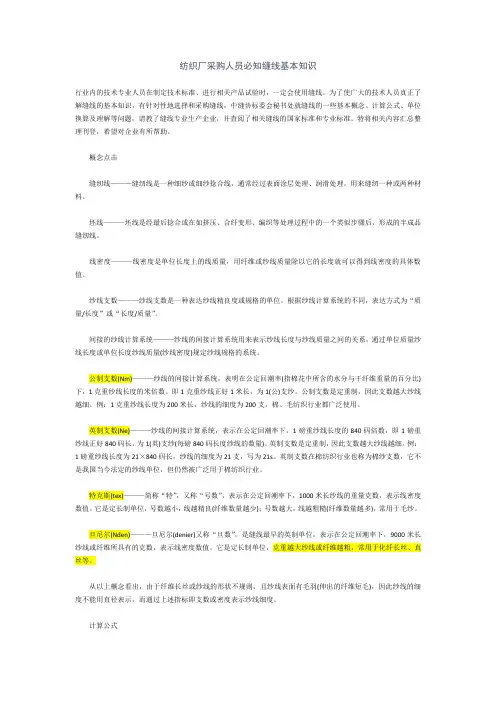
纺织厂采购人员必知缝线基本知识行业内的技术专业人员在制定技术标准、进行相关产品试验时,一定会使用缝线。
为了使广大的技术人员真正了解缝线的基本知识,有针对性地选择和采购缝线,中缝协标委会秘书处就缝线的一些基本概念、计算公式、单位换算及理解等问题,请教了缝线专业生产企业,并查阅了相关缝线的国家标准和专业标准。
特将相关内容汇总整理刊登,希望对企业有所帮助。
概念点击缝纫线———缝纫线是一种细纱或细纱捻合线,通常经过表面涂层处理、润滑处理,用来缝纫一种或两种材料。
坯线———坯线是经最后捻合或在如挤压、合纤变形、编织等处理过程中的一个类似步骤后,形成的半成品缝纫线。
线密度———线密度是单位长度上的线质量,用纤维或纱线质量除以它的长度就可以得到线密度的具体数值。
纱线支数———纱线支数是一种表达纱线精良度或规格的单位,根据纱线计算系统的不同,表达方式为“质量/长度”或“长度/质量”。
间接的纱线计算系统———纱线的间接计算系统用来表示纱线长度与纱线质量之间的关系,通过单位质量纱线长度或单位长度纱线质量(纱线密度)规定纱线规格的系统。
公制支数(Nm)———纱线的间接计算系统,表明在公定回潮率(指棉花中所含的水分与干纤维重量的百分比)下,1克重纱线长度的米倍数。
即1克重纱线正好1米长,为1(公)支纱。
公制支数是定重制,因此支数越大纱线越细。
例:1克重纱线长度为200米长,纱线的细度为200支,棉、毛纺织行业都广泛使用。
英制支数(Ne)———纱线的间接计算系统,表示在公定回潮率下,1磅重纱线长度的840码倍数,即1磅重纱线正好840码长,为1(英)支纱(每磅840码长度纱线的数量)。
英制支数是定重制,因此支数越大纱线越细。
例:1磅重纱线长度为21×840码长,纱线的细度为21支,写为21s。
英制支数在棉纺织行业也称为棉纱支数,它不是我国当今法定的纱线单位,但仍然被广泛用于棉纺织行业。
特克斯(tex)———简称“特”,又称“号数”,表示在公定回潮率下,1000米长纱线的重量克数,表示线密度数值。
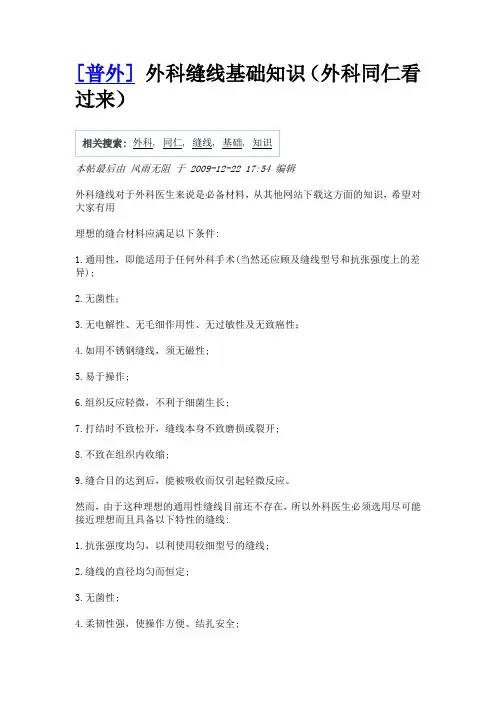
[普外]外科缝线基础知识(外科同仁看过来)本帖最后由风雨无阻于 2009-12-22 17:54 编辑外科缝线对于外科医生来说是必备材料,从其他网站下载这方面的知识,希望对大家有用理想的缝合材料应满足以下条件:1.通用性,即能适用于任何外科手术(当然还应顾及缝线型号和抗张强度上的差异);2.无菌性;3.无电解性、无毛细作用性、无过敏性及无致癌性;4.如用不锈钢缝线,须无磁性;5.易于操作;6.组织反应轻微,不利于细菌生长;7.打结时不致松开,缝线本身不致磨损或裂开;8.不致在组织内收缩;9.缝合目的达到后,能被吸收而仅引起轻微反应。
然而,由于这种理想的通用性缝线目前还不存在,所以外科医生必须选用尽可能接近理想而且具备以下特性的缝线:1.抗张强度均匀,以利使用较细型号的缝线;2.缝线的直径均匀而恒定;3.无菌性;4.柔韧性强,使操作方便、结扎安全;5.不含刺激性物质或杂质,以利组织相容;6.缝合结果可信任。
型号与抗张强度型号表示缝合材料的直径。
外科惯例公认,应选用能使组织安全对合的最细型号缝线,使缝合所致的创伤减至最低限度。
缝线的型号以数字表示:"0"号以上,数码越大,缝线越粗,如3号粗于1号;从 "0"开始,"0"号越多,直径越小,抗张强度亦越低。
缝线结的抗张强度是其在断裂前所能承受的力度(以磅表示)。
有关组织的抗张强度是外科医生选择缝线型号和抗张强度的先决条件。
外科医生还应了解,缝线强度渐减和伤口抗张强度渐增间的相互关系,以及植入材料所致的异物反应是否影响组织的愈合过程。
一般公认,缝线的抗张强度不需超过组织的抗张强度,但至少应与其所缝的正常组织等强。
单纤维与多纤维缝线单纤维缝线由单一纤维制成,在穿过组织时所遇阻力较小,且可避免细菌在上附着。
由于这些品性,特别适用于血管外科。
单纤维缝线易于打结。
但在操作和结扎时必须谨慎从事,因折叠或卷曲都可能给缝线造成缺口或薄弱点,以致断裂。
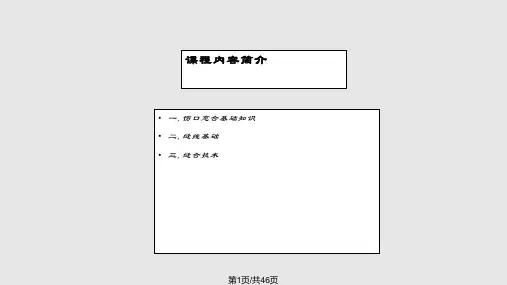
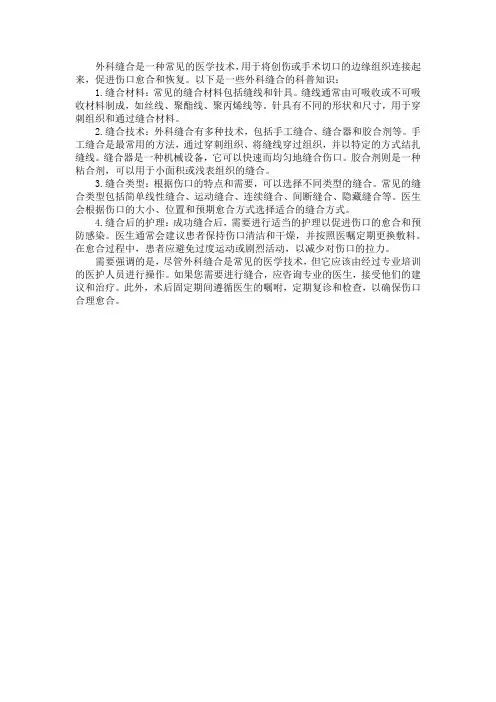
外科缝合是一种常见的医学技术,用于将创伤或手术切口的边缘组织连接起来,促进伤口愈合和恢复。
以下是一些外科缝合的科普知识:
1.缝合材料:常见的缝合材料包括缝线和针具。
缝线通常由可吸收或不可吸收材料制成,如丝线、聚酯线、聚丙烯线等。
针具有不同的形状和尺寸,用于穿刺组织和通过缝合材料。
2.缝合技术:外科缝合有多种技术,包括手工缝合、缝合器和胶合剂等。
手工缝合是最常用的方法,通过穿刺组织、将缝线穿过组织,并以特定的方式结扎缝线。
缝合器是一种机械设备,它可以快速而均匀地缝合伤口。
胶合剂则是一种粘合剂,可以用于小面积或浅表组织的缝合。
3.缝合类型:根据伤口的特点和需要,可以选择不同类型的缝合。
常见的缝合类型包括简单线性缝合、运动缝合、连续缝合、间断缝合、隐藏缝合等。
医生会根据伤口的大小、位置和预期愈合方式选择适合的缝合方式。
4.缝合后的护理:成功缝合后,需要进行适当的护理以促进伤口的愈合和预防感染。
医生通常会建议患者保持伤口清洁和干燥,并按照医嘱定期更换敷料。
在愈合过程中,患者应避免过度运动或剧烈活动,以减少对伤口的拉力。
需要强调的是,尽管外科缝合是常见的医学技术,但它应该由经过专业培训的医护人员进行操作。
如果您需要进行缝合,应咨询专业的医生,接受他们的建议和治疗。
此外,术后固定期间遵循医生的嘱咐,定期复诊和检查,以确保伤口合理愈合。
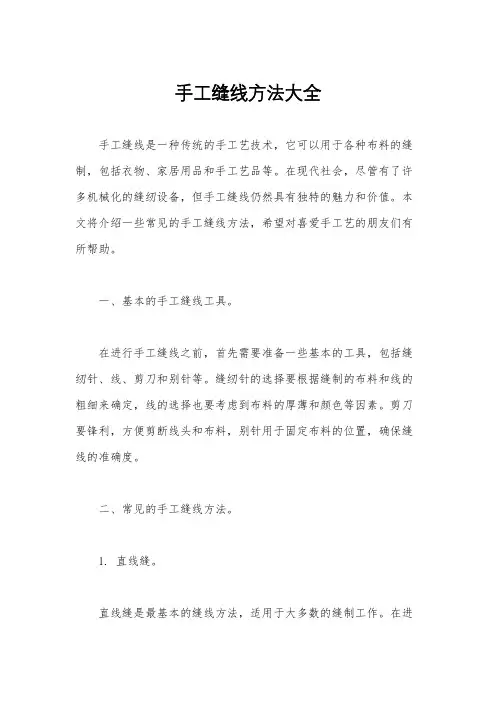
手工缝线方法大全手工缝线是一种传统的手工艺技术,它可以用于各种布料的缝制,包括衣物、家居用品和手工艺品等。
在现代社会,尽管有了许多机械化的缝纫设备,但手工缝线仍然具有独特的魅力和价值。
本文将介绍一些常见的手工缝线方法,希望对喜爱手工艺的朋友们有所帮助。
一、基本的手工缝线工具。
在进行手工缝线之前,首先需要准备一些基本的工具,包括缝纫针、线、剪刀和别针等。
缝纫针的选择要根据缝制的布料和线的粗细来确定,线的选择也要考虑到布料的厚薄和颜色等因素。
剪刀要锋利,方便剪断线头和布料,别针用于固定布料的位置,确保缝线的准确度。
二、常见的手工缝线方法。
1. 直线缝。
直线缝是最基本的缝线方法,适用于大多数的缝制工作。
在进行直线缝时,需要将两块布料对齐,用别针固定,然后用缝纫针穿插布料,保持线头的长度一致,使得缝线整齐美观。
2. 环形缝。
环形缝适用于缝制圆形或曲线形状的布料,比如裙摆、袖口等。
在进行环形缝时,需要将布料的边缘对齐,用别针固定,然后用缝纫针沿着布料的边缘进行缝制,保持线头的长度一致,使得缝线平整。
3. 针线结。
针线结是用于缝制结束时的固定方法,可以防止线头松动。
在进行针线结时,需要将线头穿过缝线的下方,形成一个环,然后将线头穿入环内,再拉紧即可。
4. 手工刺绣。
手工刺绣是一种艺术性很强的手工缝线方法,适用于布料的装饰和修饰。
在进行手工刺绣时,需要根据设计图案选择合适的线头和针法,然后按照设计图案进行缝制,保持线头的长度一致,使得刺绣效果美观。
5. 补缀。
补缀是一种修补布料的手工缝线方法,适用于布料的破损和磨损部位。
在进行补缀时,需要选择与布料相符的线头和布料,然后根据破损部位进行缝制,保持线头的长度一致,使得修补效果自然。
三、手工缝线的注意事项。
1. 确保工具的清洁和整洁,保持缝线的质量和美观度。
2. 根据不同的布料选择合适的缝纫针和线头,保证缝线的牢固度和美观度。
3. 在进行手工缝线时,要保持手的稳定和线头的长度一致,使得缝线整齐美观。
针线知识点总结针线是人类最早用来缝制、织造和装饰的工具,它的运用范围广泛,涉及到服装、家居用品、手工艺品等各个领域。
因此,掌握针线知识是非常重要的,不仅可以修复衣物,还可以进行手工创作。
本文将围绕针线知识点展开,从针、线、针法以及常见的缝纫技巧等多个方面展开介绍。
一、针的种类和选择1. 针的种类(1)普通缝纫针:用于一般的纺织品、布料缝制。
(2)针尖针:针尖尖锐,适合于比较细腻的织物。
(3)针耳针:针眼拉长、针头细长,适合针尖的设计恰好。
(4)针尖针:针尖加宽厚,适用于较厚的织物。
2. 针的选择(1)根据缝纫的织物类型选择:如薄织物、厚织物、弹性织物等。
(2)根据缝合的部位选择:如扣眼、滚边、拼接等。
(3)根据针孔的大小选择:如细孔、大孔等。
二、线的种类和选择1. 线的种类(1)棉线:适用于一般缝纫,但易断裂。
(2)聚酯线:强度高,适用于牛仔裤等。
(3)尼龙线:弹性好,适用于弹性织物。
(4)丝线:质地轻柔,适用于高级服装。
2. 线的选择(1)与织物相对应:如粗细要与织物匹配。
(2)与针的大小相对应:如线太粗,会扩大针眼,线太细,容易断裂。
(3)与颜色相匹配:线的颜色要与织物相协调。
三、常见的针法1. 手针法(1)握针法:用拇指和食指夹住针柄,使得针头处于手指间缝隙。
(2)持针法:在握针法的基础上,大拇指和食指中还增加了一个拿线的动作。
2. 打结法每次缝针时,要先在线头上打一个小结,保持线头不易脱落。
3. 开线法将线头从针的前端穿过,留出一段线头,然后再将线头折叠上去,即可开始缝制。
四、常见的缝纫技巧1. 手工缝纫(1)基本缝法:包括直线缝、直梭线、锁边线、双针线等。
(2)缝纫装饰:如刺绣、镶边、珠片等。
2. 机器缝纫(1)基本操作:包括调节线迹、调节张力、调整缝距等操作。
(2)缝纫装饰:如绣花、电脑刺绣等。
3. 手工艺品缝制(1)制作玩偶:包括填充玩偶、拼布玩偶等。
(2)制作袋子:如手提包、化妆包等。
外科缝线基础知识(Basics of surgical sutures)Surgical sutures are necessary materials for surgeons, and download this knowledge from other websites in the hope that they will be useful to youIdeal stitching materials shall meet the following conditions:1. versatility, which can be applied to any surgical procedure (of course, taking into account the differences in stitch type and tensile strength);2. sterility;3., no electrolysis, no capillary action, no allergy and no carcinogenicity;4. if stainless steel suture, must have no magnetism;5. easy to operate;6., the tissue reaction is slight, is not conducive to bacterial growth;7. do not loosen the knot, the suture itself does not wear or split;8. does not shrink within the tissue;9. suture after the arrival of, can be absorbed, and only minor reactions.However, because of this ideal versatility, sutures do not currently exist, so surgeons must choose sutures that are as close as possible to the ideal and have the following characteristics:1., tensile strength uniform, in order to use the finer type of suture;The diameter of the 2. sutures is uniform and constant;3. sterility;4. strong flexibility, easy to operate, safe ligation;5. does not contain irritating substances or impurities to facilitate tissue compatibility;6. suture results can be trusted.Model and tensile strengthThe model indicates the diameter of the stitching material. Surgical practice is generally accepted that the finest type of suture that allows tissue to fit safely should be selected to minimize the suture induced trauma. The number of stitches is indicated by numbers: "No. 0" or more. The larger the number, the thicker the seam, such as "No. 3 is thicker than 1"; from "0", "0", the smaller the diameter, the lower the tensile strength.The tensile strength of a suture is what it can withstand beforebreaking (expressed in pounds). The tensile strength of the tissue is a prerequisite for the surgeon to select the type of suture and the tensile strength. The surgeon should also understand, thread strength decreasing and the relationship between the tensile strength increasing wound resistance between the implant materials and whether caused by foreign body reaction affect the healing process of the organization. It is generally accepted that the tensile strength of the suture does not exceed the tensile strength of the tissue, but at least it should be stronger than the normal tissue.Single fiber and multi fiber sutureThe single fiber suture is made of a single fiber, which is less resistant to passing through the tissue and prevents bacteria from sticking. Because of these characteristics, it is especially suitable for vascular surgery. Single fiber sutures are easy to tie. But in operation and ligation must be careful, because folding or curling may cause suture gap or weak point, so that fracture.Absorbable and non absorbable suturesAbsorbable sutures are prepared from the collagen or synthetic multimeric system of healthy mammals. Natural absorbable suture is through the human digestive enzymes to degrade fiber suture. The synthetic absorbable suture is first through hydrolysis, decomposition of the water gradually penetrated into the suture fiber caused by the polymer chain; and natural absorbable suture than synthetic absorbable sutures can be hydrolyzed after implantation only caused mild tissuereaction.In the first phase of suture absorption, tensile strength showed a linear and gradual decrease, which occurred within a few weeks after surgery. The second stage often overlaps with the first stage, and eventually the suture disappears.An absorbable suture that is free of enzyme digestion and hydrolysis. Its scope of application is as follows:The skin should be removed after the wound is healed;The suture in the body, leaving the length inside the tissue;Suitable for allergic, scar, or organized hypertrophy of absorbable sutures;A temporary device used to secure a defibrillator, pacemaker, or drug release device.Introduction of various suture materialsNatural absorbable sutureSurgery can be divided into: catgut catgut and chromic catgut in general. Both are processed from highly purified collagen. Surgical catgut absorption rate depends on the type of line, organizational type and condition as well as the patient's general condition. Can be used for surgical catgut suture wound infection, but the absorption rate.General surgical catgut fast absorption. Postoperative tensile strength was maintained for only 7-10 days and was completely absorbed within 70 days. The chromate solution catgut called chrome catgut, digestive enzymes function against the body, the absorption time is extended to more than 90 days.Synthetic absorbable sewing moneyBecause the natural gut has strong antigenicity, tissue reaction and the disadvantage of receiving rate are people, is committed to the development of synthetic absorbable sutures. The latter has a wide range of applications, ranging from thoracic and abdominal wound sutures to ophthalmic surgery.Coated Vicryl (Polyglactin 910) suture: it has the advantage of:1. smooth through tissue;2. knot smooth, accurate positioning;3. reduce the tendency to clamp tissue;4. can be used to stitch infected wounds.The coating is PLLA and ethylene to lipid (Polyglactin 370) copolymer mixture made with calcium stearate. The coating has remarkable absorbability, adhesion and lubricity without stripping.The tensile strength of the coated Vicryl suture remained about65% at fourteenth days after the suture. Twenty-first days after suture, 6 a 0 or more coarse type suture tensile strength of about 7 and retained 40%, a 0 or more thin line retained only about 30%. Within 40 days, the stitches were hardly absorbed, and were absorbed in 56 and 70 days. The absorption of the paint is also very rapid, and it is estimated to be between 56 and 70 days.Polydioxanone (PDS II) suture: this single fiber suture represents significant progress in suture materials. It is soft, flexible and single fiber structure characteristics in one, good absorption properties, can maintain the tensile strength of the wound more than 6 weeks (two times for other synthetic absorbable sutures), mild tissue reaction and low affinity to bacteria. The utility model is suitable for suture of a plurality of soft tissues, and can be used for cardiovascular, obstetrical, ophthalmology, plastic surgery, digestive tract and colon operation in children.Similar to other synthetic absorbable sutures, PDS II loops are absorbed in vivo by hydrolysis. After the suture, the tensile strength of the fourteenth Tianbao was about 70%, 50% on the 28 day and 42 on the 25% day. The suture was hardly absorbed within 90 days after operation and was completely absorbed after 6 monthsMonocryI (PoIiglecaprone 25) suture: this kind of single fiber suture is flexible, easy to operate, easy to knot, no chemical action in the tissue, and can be absorbed as scheduled. Surgeons commonly use tissue suture requiring higher tensile strength within two weeks after surgery, which is suitable forsubcutaneous suture, soft tissue alignment and ligation besides nerves, blood vessels, ophthalmology and microsurgery. The original strength of 50%~60% could be retained at seventh days, decreased to 20%~30% at fourteenth days, and disappeared at twenty-first days. 91 and 119 days are completely absorbed.Absorbable sutureThe USP divides non absorbable surgical sutures into the following categories:Class I: twisted or woven or single fiber yarn or synthetic fiber;Class II: cotton or linen fibers, coated with natural or synthetic fibers, used to thicken seams without increasing strength;Class III: a single strand or multiple strands of metal wire.Surgical threadBecause of the excellent operability of the surgical thread, it has become a standard for surgeons to evaluate the performance of new synthetic materials. The natural single fiber silk can be made into silk thread by two kinds of twisting, twisting or knitting processes, among which the knitting type surgical thread has the best operation performance.Alloy sutureStainless steel suture: the basic characteristics include non-toxic, easy bending, slender and so on. Two kinds of suture, single fiber and twist twist, have the advantages of large tensile strength, low tissue reaction and convenient knot tying. As long as the suture is not broken, the tensile strength of the tissue is very little changed. The stainless steel suture can be used for abdominal wall, sternal suture, skin suture, tension reduction suture, and various orthopedic and Department of Neurosurgery operations.Synthetic non absorbable sutureNylon suture: a chemically synthesized polyamide polymer. Because of its better elasticity, it is especially suitable for tension reduction, suture and skin suture. In vivo, nylon sutures are hydrolyzed at a rate of 15%~20% per year. The single strand nylon thread has the tendency to restore its original linear state ("memory" characteristic), so it should be more than a few times to make sure that it is safe and reliable when compared with the woven nylon suture.ETHILON is a nylon suture with minimal tissue response, in which the very fine model (9-0,10-0) is dyed black and is often used in ophthalmology and microsurgery.NUROLON is made of nylon fiber fine knit and coated to improve its operability. The appearance, feel and operation are like silk thread, but the intensity is greater and the reaction of tissue is slight. Any tissue that can be applied to multiple strands without absorbable sutures.Polyester fiber suture: by the treated polyester fiber (poly ethylene terephthalate) multi fiber suture closely woven, a natural fiber tougher before use wet will not weaken the strength of the organization, reflect slight. Polyester fiber suture is the best material to suture artificial blood vessel.MERSILENE polyester fiber suture can be retained in the body for a long time, providing accurate and uniform tension, rarely damaged, and without the need to stimulate the removal of suture residue. After eye surgery, the MERSlLENE suture hardly causes burning pain and itching. Because of the absence of a coating, the MERSlLENE thread passes through the tissue with a higher coefficient of friction.ETHlBOND high quality polyester fiber threads are evenly coated with polybutilate. The latter is the first kind of coating specially used as a lubricant for surgical sutures. It can adhere to stitches of woven polyester fibers. This kind of coating makes knitting stitches easy to traverse,It has excellent flexibility and operability, and can be firmly ligated and fastened. The pharmacological properties of suture materials and coatings are not active, and the tissue response is slight, and the strength of the suture can be maintained for a long time in vivo. ETHIBOND quality suture is mainly used in cardiovascular surgery, such as vascular anastomosis, artificial blood vessel or valve suture, etc.. ETHIBOND high quality polyester suture can also be used with TEFLON or polyester pad. The small spacer serves as a support under the suture to prevent avulsion of the adjacent fragile tissue. Small pads are routinely used in valve surgery and are used incases of abnormal deformity, distortion, or destruction of the valve ring.Polypropylene (POLYPROPYLENE) sutures: polypropylene sutures are a solid isomer of linear hydroxy polymers. The polypropylene thread produced by the patented process increases flexibility and is easy to use. Not easily degraded or weakened by enzymes. The activity of the tissue is very weak and the tissue is mild and the tensile strength can be maintained in the body for two years. Compared with other types of single fiber suture, knot knot is more stable and firm.PROLENE polypropylene suture has been widely used in general surgery, cardiovascular surgery, plastic surgery and ophthalmology. The suture has weak biological activity and is not easy to adhere to tissues and is easy to remove. PROLENE can be used to suture pollution and wound infection, sinus formation and suture the post discharge can be reduced to the lowest level.Selection principle of sutureAmong the many choices surgeons face, the choice of sutures for different operations is also one of the key issues. Of course, the surgeon's personal preference plays a role, but the various factors affecting the healing, the characteristics of the tissue involved, and the possible postoperative complications will affect the final selection of the suture.A wide variety of suture materials may make people feel at a loss when making a choice. The following principles are usedas guidelines:1. when the wound reaches maximum strength, sutures are no longer needed. Therefore:Also must use non absorbable suture or aging long absorbable suture to suture the slow healing tissues (such as skin, fascia, tendon, etc.);Those with absorbable suture suture to heal faster tissue (such as stomach, colon, bladder, etc.).2., the organization of foreign body memory can make pollution into infection. Therefore:Those in suture wound contaminated, avoid the use of multiple fiber sutures;The use of single fiber suture or absorbable suture.3., in emphasizing the beauty of the site, should pay attention to precise and long time to organize, and avoid the use of various stimuli. Therefore:The use of the most slender, no reaction of single fiber suture material (such as nylon, polypropylene);"As far as possible at the same time suturing subcutaneous tissue;Even if circumstances permit, the application of sterile skinadhesive tape.4. in a high concentration crystalloid solution, any foreign substance may precipitate precipitation and stone formation. Therefore:Those in the urinary tract and biliary surgery, should use absorbable suture5. about the choice of stitch type:The use of sutures and natural strength to match the seam line;。